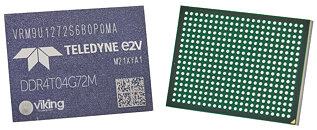- Joined
- Oct 9, 2007
- Messages
- 47,692 (7.42/day)
- Location
- Dublin, Ireland
| System Name | RBMK-1000 |
|---|---|
| Processor | AMD Ryzen 7 5700G |
| Motherboard | Gigabyte B550 AORUS Elite V2 |
| Cooling | DeepCool Gammax L240 V2 |
| Memory | 2x 16GB DDR4-3200 |
| Video Card(s) | Galax RTX 4070 Ti EX |
| Storage | Samsung 990 1TB |
| Display(s) | BenQ 1440p 60 Hz 27-inch |
| Case | Corsair Carbide 100R |
| Audio Device(s) | ASUS SupremeFX S1220A |
| Power Supply | Cooler Master MWE Gold 650W |
| Mouse | ASUS ROG Strix Impact |
| Keyboard | Gamdias Hermes E2 |
| Software | Windows 11 Pro |
Teledyne e2v has announced the DDR4T04G72M - the first radiation-tolerant DDR4 memory chip, featuring a total 4 GB capacity. Currently validated at 2133 MT/s, and targeting to offer 2400MT/s in the near future, this next-generation solution offers ultra-responsive low latency operation, while fitting into a highly compact form factor. Furthermore, high-reliability manufacturing and radiation-tolerant robustness makes it highly suitable for dealing with the rigors of space environments.
With 15 mm x 20 mm x 1.92 mm dimensions, this new space-grade device comprises an array of Micron based memory chips, integrated in a single package. It features a 72-bit bus, where 64 bits are dedicated to data and 8 bits to error correction code (ECC). Radiation tests have been performed on these memory chips and a single event effects (SEE) report is available from Teledyne e2v. In particular, the memory has been demonstrated to be single event latch-up (SEL) free up to 60+ MeV.cm²/mg.

This new space-grade DDR4 memory enables elevated levels of performance, while taking up minimal board real estate - something that is certain to be of value in highly space-constrained, densely-packed satellite designs. It can be used in conjunction with processors and FPGAs having a DDR4 controller, and is in particular embedded on Teledyne e2v Space version of Qormino Common Compute Platform together with a space version of NXP LS1046 quad core processor (QLS1046-4 GB).
The thermally-enhanced packaging technology accelerates heat dissipation, in order to maintain continued operational reliability. Flight Models will be available up to an extended temperature range of -55°C to 125°C. It is compliant with NASA Level 1 (NASA EEE-INST-002 - Section M4 - PEMs) and ECSS Class 1 (ECSS-Q-ST-60-13C).
"The combination of radiation tolerance, rugged construction and small form factor, make this Radiation Tolerant 4 GB DDR4 memory a very appealing solution for integration into space-oriented systems," states Thomas Guillemain, Marketing & Business Development Manager at Teledyne e2V Semiconductors. "This space-grade DDR4 offers the transition path to newer generations of processing devices required by compute intensive space applications".
View at TechPowerUp Main Site
With 15 mm x 20 mm x 1.92 mm dimensions, this new space-grade device comprises an array of Micron based memory chips, integrated in a single package. It features a 72-bit bus, where 64 bits are dedicated to data and 8 bits to error correction code (ECC). Radiation tests have been performed on these memory chips and a single event effects (SEE) report is available from Teledyne e2v. In particular, the memory has been demonstrated to be single event latch-up (SEL) free up to 60+ MeV.cm²/mg.

This new space-grade DDR4 memory enables elevated levels of performance, while taking up minimal board real estate - something that is certain to be of value in highly space-constrained, densely-packed satellite designs. It can be used in conjunction with processors and FPGAs having a DDR4 controller, and is in particular embedded on Teledyne e2v Space version of Qormino Common Compute Platform together with a space version of NXP LS1046 quad core processor (QLS1046-4 GB).
The thermally-enhanced packaging technology accelerates heat dissipation, in order to maintain continued operational reliability. Flight Models will be available up to an extended temperature range of -55°C to 125°C. It is compliant with NASA Level 1 (NASA EEE-INST-002 - Section M4 - PEMs) and ECSS Class 1 (ECSS-Q-ST-60-13C).
"The combination of radiation tolerance, rugged construction and small form factor, make this Radiation Tolerant 4 GB DDR4 memory a very appealing solution for integration into space-oriented systems," states Thomas Guillemain, Marketing & Business Development Manager at Teledyne e2V Semiconductors. "This space-grade DDR4 offers the transition path to newer generations of processing devices required by compute intensive space applications".
View at TechPowerUp Main Site







